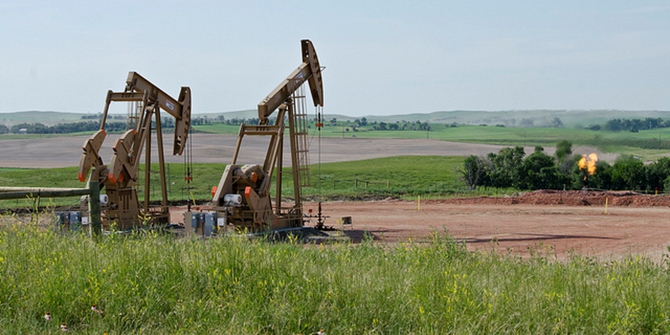 Are airports becoming the ‘new downtowns’ of American cities? In new research which examines 62 airports in 51 US metropolitan areas, Stephen Appold finds that airports are important, with a large majority anchoring their own concentrations of employment, but that this employment varies compared to that of city CBDs. He writes that understanding how much employment, of what types, and for what reason locate near airports will aid in allocating land as cities continue to change.
Are airports becoming the ‘new downtowns’ of American cities? In new research which examines 62 airports in 51 US metropolitan areas, Stephen Appold finds that airports are important, with a large majority anchoring their own concentrations of employment, but that this employment varies compared to that of city CBDs. He writes that understanding how much employment, of what types, and for what reason locate near airports will aid in allocating land as cities continue to change.
What is the spatial form U.S. cities in the early 21st-century? (The terms, “urban,” “metropolitan,” “city,” and “region” are used interchangeably here.) Despite the importance of the question for informing theory, planning and real estate development, we may have a better overview of ancient and medieval city structure than we do of our own, sometimes characterizing it simply as endless sprawl. Yet, as we approach the closing of the crabgrass frontier, understanding the cities we have created is a critical input into creating the cities we need.
Not all cities have the same structure but, in various combinations and strengths, several of the basic spatial building blocks are common: a center surrounded by a cone of decreasing density of activity, corridors along major primary access routes, clusters of employment in addition to the CBD, and, perhaps, clusters of employment near the airport. Figure 1 provides an overview of the spatial structure of one U.S. city, Charlotte, North Carolina which spills over municipal boundaries to reach over several counties and crosses a state line as well as a river. Employment is more concentrated than the at-home population. The CBD is clearly discernable at the intersection of the five primary radial routes. In addition, clusters of employment can also be seen.
Figure 1 – Charlotte Region Employment and Population Density
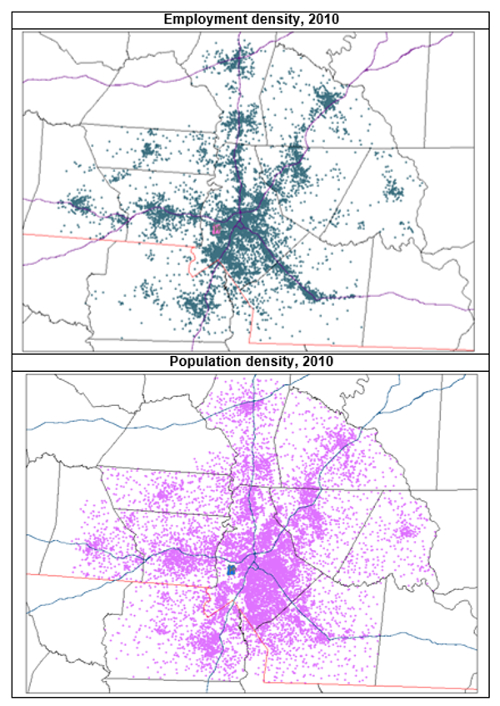
The Airport City Thesis
A handful of transportation innovations over the last century, electric street cars, automobiles, and airplanes, have had profound impacts on the size, distribution, and internal structure of cities with several authors positing an air-auto age. The infrastructure supporting these transportation modes are not intrusions upon cities but fundamental components of large contemporary cities. Nodes of transport interchange, whether central points of convergence or places of transfer between long distance and local means of transport, frequently serve as anchors for urban development. Consequently, many cities have their origins at sea harbors (New York), river junctions (Pittsburgh) or crossings (St. Louis), rail depots (Atlanta), and perhaps even highway interchanges (Tysons Corner). The acknowledged salience of such nodes in shaping cities might be best evidenced in transit-oriented and railway station development.
Airports have been said to anchor a specifically late 20th century- early 21st century urban form: airport cities (defined here as concentrations of employment on and near airports). Some have argued that, in a major re-arrangement of space, airports are becoming “the new downtowns” with terminals forming the central square (see Figure 2) of “new cities” functionally splitting away from and overtaking the “old cities” from which they had emerged.
Figure 2 – Airports as “Central Squares”
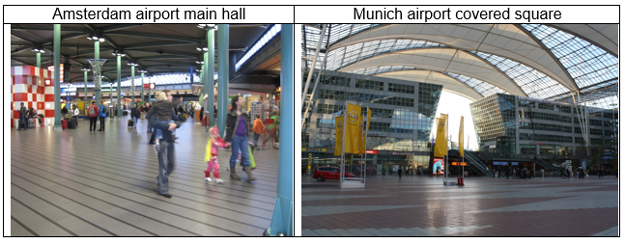
Prevalence and Importance
My recent examination of the 51 U.S. metropolitan areas with populations of one million or more in 2000 and the 62 airports with scheduled passenger service serving those cities reveals that airports are important. Airport cities not only exist, they are prevalent: 80 percent of the commercial airports included in the analysis anchor sufficient employment to constitute an employment agglomeration (using one common operationalization).
Figure 3 shows that airport cities are significant, but not dominant, urban centers. (Airport-CBD corridors are continuous agglomerations of employment including both an airport and the CBD centroid, such as in Charlotte.) Airport area employment averaged one-third to one-half that of CBDs, depending upon operationalization. Airport cities collectively accounted for a smaller proportion of metropolitan area employment than the combined non-CBD employment subcenters but were often individually larger.
Figure 3 – Percent of Urban Employment by Selected Spatial Building Block
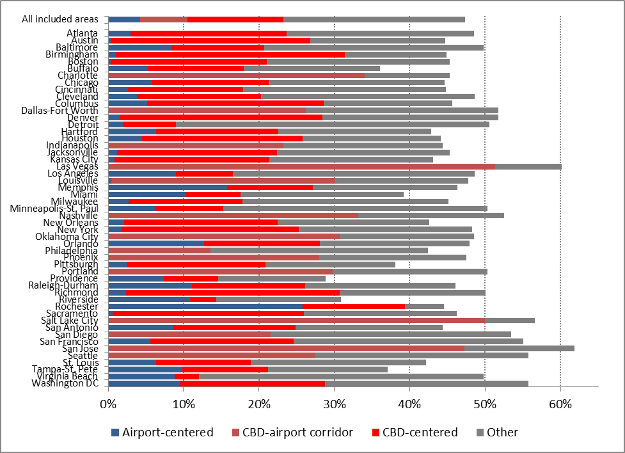
To put the impact of these building blocks of the distribution of metropolitan employment into context, Figure 4 summarizes the average percent of metropolitan employment within the specified distances of selected anchors. Airports anchor approximately the same proportion of metropolitan employment as selected large non-CBD subcenters. The relatively few major radial highways, as seen in Figure 1 above, anchor a significantly higher proportion of employment in corridors. Of course, past a point, CBDs, airports, and the centers of non-CBD subcenters tap into the overall urban activity cone. A varying, but large, proportion of employment is outside identifiable clusters.
Figure 4 – Percent of Metropolitan Employment near Key Employment Anchors

The relative employment in airport areas, compared to the CBDs, varied: the location of the airport with respect to major highways and distance from the CBD but not air-intensity, had large impacts on the relative size of the airport city. Figure 5 charts the relationship of airport city size to distance from the CBD. The timing of urban expansion may have an impact on the size of the employment agglomeration near airports. Residences often spread from the center city before employment did, pre-empting commercial development.
Figure 5 – Percent of Metropolitan Employment within One Mile of the Principal Airport and Distance of the Airport from the CBD

Airport Cities as Employment Suburbanization
Figure 6 summarizes the general specialty sectors of CBDs, airport areas, CBD-airport corridors, and non-CBD subcenters. Scores above 1 indicate specialization in that sector. Airport areas specialize first and foremost in transportation, wholesale trade, and to a lesser extent, manufacturing. Beyond that, their sectoral specializations resemble those of non-CBD subcenters. Given the disamenity, airport areas might be attractive for sectors which are not sensitive to noise, such as manufacturing and wholesaling, but require access to urban markets, highways, and labor pools even when they have little connection to aviation. The hedonic pricing literature finds that airports exert both a positive access effect and a much stronger noise effect on residential homes. Although no systematic research has been found, the relative strength of the impacts are likely reversed for commercial real estate, even if there is no strong need for airport access.
Figure 6 – Sector Employment Location Quotients by Type of Urban Element

Central cities have retained their spatial dominance to a surprising degree. Employment in sectors which rely heavily on air transportation remains concentrated in CBDs. Public administration, finance, information, and professional services are more over-represented in CBDs than elsewhere. Airport cities are essentially suburban employment subcenters with an airport.
Residential Location and Airport City Size
The above summarizes the overall tendency but, as Figure 5 suggests, there is wide variation in airport city size and character. High-status residential areas are one factor which may help pull (air transportation-using) producer service employment in their direction and push manufacturing and distribution away. Figure 7 and Figure 8 map the contrasting Atlanta and Dallas-Fort Worth (DFW) regions, respectively. In these maps, blue indicates that population exceeds employment and red the opposite. The deeper the blue, the higher the average household income is; the deeper the red, the higher the density of employment. In Atlanta, many of the high density employment areas are to the north of the CBD. The same holds in Dallas-Fort Worth but in that case, the airports are also and the corridor of high density employment stretches from central Dallas northwest past Love field, to, and perhaps beyond, DFW. The statistical results of the analyses testing for the impact of such residential districts are suggestive, but not conclusive.
Figure 7 – Employment Density (red) and Household Income (blue) in Atlanta, 2000
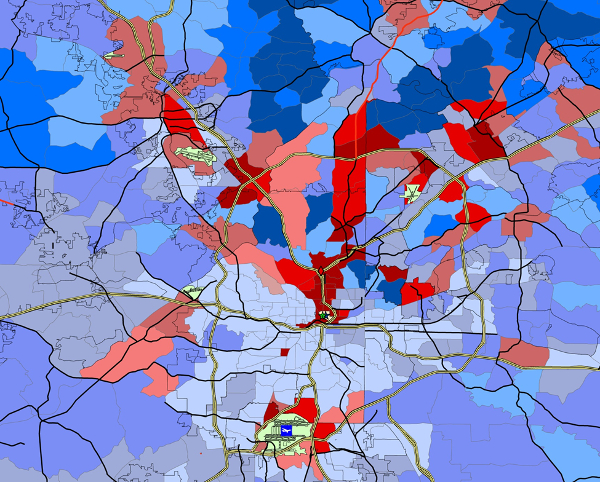
Figure 8 – Employment Density (red) and Household Income (blue) in Dallas-Fort Worth, 2000
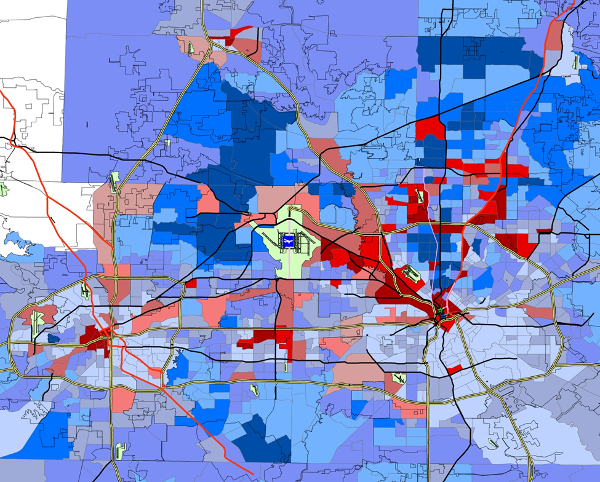
Implications for planning
Discussions surrounding the proposed Thames Estuary Airport in London, Chicago’s O’Hare modernization project, and the redevelopment of LaGuardia airport in New York underscore the importance of airport area planning. Understanding how much employment, of what types, and for what reason locate near airports will aid in allocating land among uses, hopefully with the effect of maximizing safety, minimizing noise disamenity, and more efficiently using increasingly scarce urban land as denser development spills over into what have been termed urban grey areas.
It should be emphasized that the volume of employment surrounding an airport is not a measure of its value to a city. Rather airports are one component of a system of air transportation which can help reduce the costs of trade and thereby catalyze outwardly-looking urban economic activity. Over the course of the second half of the 20th century, the U.S. economy became almost three times more passenger air-intensive than it was in the 1950s, reaching approximately 60 revenue-passenger-miles per $1,000 of GDP. The growth in air travel may have slowed in the U.S. as the market approaches saturation but there is an accelerating need to better integrate airports into urban design as cities remake themselves for new uses.
This article is based on the paper ‘Airport cities and metropolitan labor markets: an extension and response to Cidell’, in the Journal of Economic Geography.
Featured image credit: Supplied by author.
Please read our comments policy before commenting.
Note: This article gives the views of the author, and not the position of USAPP – American Politics and Policy, nor of the London School of Economics.
Shortened URL for this post: http://bit.ly/1NIEdr7
_________________________________
 Stephen Appold – The University of North Carolina, Chapel Hill
Stephen Appold – The University of North Carolina, Chapel Hill
Stephen Appold is at the Kenan Institute of Private Enterprise, Kenan-Flagler Business School, at the University of North Carolina, Chapel Hill. His research interests include airport cities and the spatial structure of contemporary cities.


